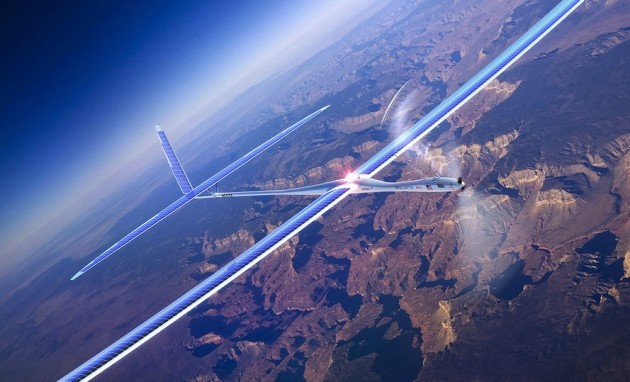The latest twist in the race to provide high-speed Internet access from above comes in the form of a report in The Guardian, to the effect that a hush-hush Google project called SkyBender is testing drones in the skies above Spaceport America in New Mexico.
The Guardian says it’s obtained documents laying out how high-altitude drones could relay gigabits of data per second, using millimeter-wave, phased-array transmissions. Jacques Christophe Rudell, an electrical engineering professor at the University of Washington, is quoted as saying that “the huge advantage is access to new spectrum, because the existing cellphone spectrum is overcrowded.”
Millimeter-wave communications could open the way for 5G wireless service that’s 40 times faster than the current 4G LTE standard. But millimeter-wave signals have a relatively short range: According to The Guardian, Project SkyBender would have to use thousands of transceiver-equipped aerial vehicles to knit together the network.

The system is reportedly being tested using Aurora Flight Sciences’ Centaur optionally piloted aircraft as well as the solar-powered drones made by Titan Aerospace, which was acquired by Google in 2014 after a fling with Facebook.
The Guardian says the project is taking advantage of facilities at Spaceport America, including 15,000 square feet of space in Virgin Galactic’s terminal building. Virgin Galactic had been planning to house its SpaceShipTwo suborbital rocket plane in the New Mexico hangar by now, but in 2014, a fatal accident during a California test flight put the company’s timetable on hold.
The Guardian report puts a $300,000 price tag on the New Mexico tests, which are due to run through July. Neither Google Access nor its parent company, Alphabet, has commented publicly on Project SkyBender.
Because of the delays for Virgin Galactic, Spaceport America sees drone operations as an important revenue source to fill its fiscal gap, at least until SpaceShipTwo begins flying customers in 2018 or later. The spaceport has been planning a three-day summit for drone operators and enthusiasts.
SkyBender isn’t the only project aiming to provide high-speed Internet access from overhead. Google also has Project Loon, which is testing balloon-borne telecommunication platforms. Facebook is moving ahead with its own drone-based platform for Internet service. Meanwhile, OneWeb and SpaceX are working on satellite systems for global high-speed data networks.
Update for 10:30 a.m. PT Feb. 1: Spaceport America originally scheduled its drone summit in March, but now it says the event “has been postponed due to the new FAA flight regulations for small drones.” This report has been updated to downplay the timing of the event.
